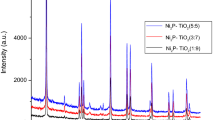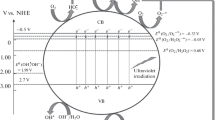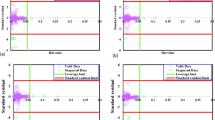Abstract
This study investigates the application of an Artificial Neural Network (ANN) to forecast the efficiency of photocatalytic degradation of the antibiotic Amoxicillin (AMX) in the presence of Zirconium dioxide as a catalyst under UV radiation. The evaluation of photocatalytic degradation efficiency is based on the reduction in Chemical Oxygen Demand (COD). The experiments involved varying the pH and using catalyst doses ranging from 0.05 to 0.25 g/L with a duration of 180 min. Remarkably, under natural pH conditions and a catalyst dose of 0.20 g/L, a degradation efficiency of 66.66% was achieved within 0.5 h. Furthermore, under optimized experimental parameters, the photocatalytic process produced 62.7 µmol/L of hydrogen gas after 90 min. The ANN model effectively predicted degradation efficiency by taking pH, catalyst dose, and time as input variables, and COD removal as the output variable. The study achieved a strong correlation coefficient of 95.00% between the predicted and experimental results, confirming the model’s suitability for forecasting the degradation process.



Similar content being viewed by others
Data availability
We guarantee the authenticity and reliability of the data.
References
Ellepola N, Rubasinghege G (2022) Heterogeneous photocatalysis of amoxicillin under natural conditions and high-intensity light: fate, transformation, and mineralogical impacts. Environments 9(7):77. https://doi.org/10.3390/environments9070077
Karamanlis VDLXN, Koveos SPPDS (2018) Effects of the antibiotic amoxicillin on key species of the terrestrial environment. Bull Environ Contam Toxicol 100:509–515. https://doi.org/10.1007/s00128-018-2302-z
Karim AV, Shriwastav A (2021) Degradation of amoxicillin with sono, photo, and sonophotocatalytic oxidation under low-frequency ultrasound and visible light. Environ Res 200:111515. https://doi.org/10.1016/j.envres.2021.111515
Verma M, Haritash AK (2020) Photocatalytic degradation of amoxicillin in pharmaceutical wastewater: a potential tool to manage residual antibiotics. Environ Technol Innov 20:101072. https://doi.org/10.1016/j.eti.2020.101072
Ayodele OB, Auta HS, Nor N (2012) Artificial neural networks, optimization and kinetic modeling of amoxicillin degradation in photo-fenton process using aluminum pillared montmorillonite-supported ferrioxalate catalyst. Ind Eng Chem Res 51:16311–16319. https://doi.org/10.1021/ie302390b
Dimitrakopoulou D, Rethemiotaki I, Frontistis Z et al (2012) Degradation, mineralization and antibiotic inactivation of amoxicillin by UV-A/TiO2 photocatalysis. J Environ Manage 98:168–174. https://doi.org/10.1016/j.jenvman.2012.01.010
Champdore MDE, Zuccato E (2004) Antibiotics in the environment: occurrence in Italian STPs, fate, and preliminary assessment on algal toxicity of amoxicillin. Environ Sci Technol 38:6832–6838. https://doi.org/10.1021/es049509a
Homem V, Santos L (2011) Degradation and removal methods of antibiotics from aqueous matrices a review. J Environ Manage 92:2304–2347. https://doi.org/10.1016/j.jenvman.2011.05.023
Chinnaiyan P, Balachandran M et al (2018) Photocatalytic degradation of metformin and amoxicillin in synthetic hospital wastewater: effect of classical parameters. Int J Environ Sci Technol 16(10):5463–5474. https://doi.org/10.1007/s13762-018-1935-0
Gondal MA, Hameed A, Yamani ZH, Suwaiyan A (2004) Production of hydrogen and oxygen by water splitting using laser induced photo-catalysis over Fe2O3. Appl Catal A Gen 268:159–167. https://doi.org/10.1016/j.apcata.2004.03.030
Acar C, Dincer I, Naterer GF (2016) Review of photocatalytic water-splitting methods for sustainable hydrogen production. Int J Energy Res 40:1449–1473. https://doi.org/10.1002/er.3549
Preethi V, Kanmani S (2018) Performance of nano photocatalysts for the recovery of hydrogen and sulphur from sulphide containing wastewater. Int J Hydrogen Energy 43:3920–3934. https://doi.org/10.1016/j.ijhydene.2017.11.006
Ni M, Leung MKH, Leung DYC, Sumathy K (2007) A review and recent developments in photocatalytic water-splitting using TiO2 for hydrogen production. Renew Sustain Energy Rev 11:401–425. https://doi.org/10.1016/j.rser.2005.01.009
Ahmad H, Kamarudin SK, Minggu LJ, Kassim M (2015) Hydrogen from photo-catalytic water splitting process: a review. Renew Sustain Energy Rev 43:599–610. https://doi.org/10.1016/j.rser.2014.10.101
Hsieh W, Ruhsing J, Huang C et al (2010) Enhance the photocatalytic activity for the degradation of organic contaminants in water by incorporating TiO2 with zero-valent iron. Sci Total Environ 408:672–679. https://doi.org/10.1016/j.scitotenv.2009.07.038
Li J, Meng S, Niu J, Lu H (2017) Electronic structures and optical properties of monoclinic ZrO2 studied by first-principles local density approximation + U approach. J Adv Ceram 6:43–49. https://doi.org/10.1007/s40145-016-0216-y
Rani S, Aggarwal M, Kumar M et al (2016) Removal of methylene blue and rhodamine B from water by zirconium oxide/graphene. Water Sci 30:51–60. https://doi.org/10.1016/j.wsj.2016.04.001
Huang J, Liu J, Tian L et al (2021) Ultrathin carbon-coated Zr3 + –ZrO2 nanostructures for efficient visible light photocatalytic antibiotic elimination. Chem Eng J 412:128621. https://doi.org/10.1016/j.cej.2021.128621
Sethi S, Dhir A, Arora V (2023) Intervention of artificial intelligence to predict the degradation and mineralization of amoxicillin through photocatalytic route using nickel phosphide-titanium dioxide catalyst. Reac Kinet Mech Cat 136:549–565. https://doi.org/10.1007/s11144-023-02360-9
Frontistis Z, Daskalaki VM, Hapeshi E et al (2012) Photocatalytic (UV-A/TiO2) degradation of 17α- ethynylestradiol in environmental matrices: experimental studies and artificial neural network modeling. J Photochem Photobiol A Chem 240:33–41. https://doi.org/10.1016/j.jphotochem.2012.05.007
Dutta S, Parsons SA, Bhattacharjee C et al (2010) Development of an artificial neural network model for adsorption and photocatalysis of reactive dye on TiO2 surface. Expert Syst Appl 37:8634–8638. https://doi.org/10.1016/j.eswa.2010.06.090
Benramdane IK, Nasrallah N, Amrane A et al (2020) Optimization of the artificial neuronal network for the degradation and mineralization of amoxicillin photoinduced by the complex ferrioxalate with a gradual and progressive approach of the ligand. J Photochem Photobiol A Chem. https://doi.org/10.1016/j.jphotochem.2020.112982
Khayet M, Cojocaru C (2012) Artificial neural network modeling and optimization of desalination by air gap membrane distillation. Sep Purif Technol 86:171–182. https://doi.org/10.1016/j.seppur.2011.11.001
Al-Araimi MM, Varghese MJ, Nageswara Rao LS, Feroz S (2019) Optimization and assessment of residual chlorine using response surface methodology (RSM) and artificial neural network (ANN) modeling. Int J Recent Technol Eng 8:258–263. https://doi.org/10.35940/ijrte.C4122.098319
Baird RB, Eaton AD, Rice EW (2017) 2540 Solids, American Public Health Association and American Water Works Association, 1995. Standard methods for the examination of water and wastewater. In Standard methods for the examination of water and wastewater
Rasamoelina D (2020) A review of activation function for artificial neural network. IEEE 18th world symposium on applied machine intelligence, 281–286. https://doi.org/10.1109/SAMI48414.2020.9108717
Mercioni, Adriana M, Holban S (2021) Soft-clipping swish: a novel activation function for deep learning. IEEE 15th international symposium on applied computational intelligence and informatics, 225–230. https://doi.org/10.1109/SACI51354.2021.9465622
Ramachandran P, Zoph B, Le QV (2018) Searching for activation functions. 6th Int Conf learn represent ICLR 2018—work track proc, 1–13. https://doi.org/10.48550/arXiv.1710.05941
Jinsakul N, Tsai CF, Tsai CE, Wu P (2019) Enhancement of deep learning in image classification performance using Xception with the swish activation function for colorectal polyp preliminary screening. Mathematics 7(12):1170. https://doi.org/10.3390/math7121170
Nwankpa C, Ijomah W, Gachagan A, Marshall S (2018) Activation functions: comparison of trends in practice and research for deep learning. arxiv:1811.03378
Tabatabai-Yazdi FS, Ebrahimian Pirbazari A, Esmaeili Khalil Saraei F, Gilani N (2021) Construction of graphene based photocatalysts for photocatalytic degradation of organic pollutant and modeling using artificial intelligence techniques. Phys B Condens Matter 608:412869. https://doi.org/10.1016/j.physb.2021.412869
Zandiehnadem F, Murray RA, Ching WY (1988) Electronic structures of three phases of zirconium oxide. Phys B+C 150:19–24. https://doi.org/10.1016/0378-4363(88)90099-X
Kucio K, Sydorchuk V, Khalameida S, Charmas B (2022) Mechanochemical and microwave treatment of precipitated zirconium dioxide and study of its physical–chemical, thermal and photocatalytic properties. J Therm Anal Calorim 147:253–262. https://doi.org/10.1007/s10973-020-10285-x
Vahedi Gerdeh F, Feizbakhsh A, Konoz E, Faraji H (2020) Copper sulphide-zirconium dioxide nanocomposites photocatalyst with enhanced UV-light photocatalysis efficiency: structural and methodology. Int J Environ Anal Chem 102(19):8004–8018. https://doi.org/10.1080/03067319.2020.1843646
Makuła P, Pacia M, Macyk W (2018) How to correctly determine the band gap energy of modified semiconductor photocatalysts based on UV–Vis spectra. J Phys Chem Lett 9:6814–6817. https://doi.org/10.1021/acs.jpclett.8b02892
Elmolla ES, Chaudhuri M (2010) Photocatalytic degradation of amoxicillin, ampicillin and cloxacillin antibiotics in aqueous solution using UV/TiO 2 and UV/H2O2/TiO2photocatalysis. Desalination 252:46–52. https://doi.org/10.1016/j.desal.2009.11.003
Balarak D, Mengelizadeh N, Rajiv P, Chandrika K (2021) Photocatalytic degradation of amoxicillin from aqueous solutions by titanium dioxide nanoparticles loaded on graphene oxide. Environ Sci Pollut Res 28:49743–49754. https://doi.org/10.1007/s11356-021-13525-1
Norabadi E, Hossein A, Ghanbari R, Meshkinian A (2020) Optimizing the parameters of amoxicillin removal in a photocatalysis/ozonation process using Box – Behnken response surface methodology. Desalin Water Treat 192:234–240. https://doi.org/10.5004/dwt.2020.25728
Ledesma SE, Garcia MG, Ruiz J (2013) Expert systems with applications analysis of a variable speed vapor compression system using artificial neural networks. Expert Syst Appl 40:4362–4369. https://doi.org/10.1016/j.eswa.2013.01.015
Hecht-nielsen R (1992) Theory of the backpropagation neural network. Neural Netw Percept. https://doi.org/10.1016/B978-0-12-741252-8.50010-8
Deist TM, Patti A, Wang Z et al (2019) Simulation assisted machine learning. Bioinformatics. https://doi.org/10.1093/bioinformatics/btz199
Brook S, Brook S, York N (2000) The absolute energy positions of conduction and valence bands of selected semiconducting minerals. Am Miner 85:543–556. https://doi.org/10.2138/am-2000-0416
Funding
The authors declare that no funding was received for conducting this study.
Author information
Authors and Affiliations
Contributions
All authors contributed to the study’s conception and design, where SS performed the material preparation, experimentation, analysis, and draft preparation. All authors (AD and VA) commented on the previous version of the manuscript. All authors have read and agreed to the published version of the manuscript.
Corresponding author
Ethics declarations
Competing interests
The authors declare that they have no financial interest.
Ethical approval
Not Applicable.
Consent to participate
Not Applicable.
Consent to publish
All authors have known and agreed to publish this article in Reaction kinetics, Mechanisms, and Catalysis.
Additional information
Publisher's Note
Springer Nature remains neutral with regard to jurisdictional claims in published maps and institutional affiliations.
Supplementary Information
Below is the link to the electronic supplementary material.
Rights and permissions
Springer Nature or its licensor (e.g. a society or other partner) holds exclusive rights to this article under a publishing agreement with the author(s) or other rightsholder(s); author self-archiving of the accepted manuscript version of this article is solely governed by the terms of such publishing agreement and applicable law.
About this article
Cite this article
Sethi, S., Dhir, A. & Arora, V. Photocatalysis based hydrogen production and antibiotic degradation prediction using neural networks. Reac Kinet Mech Cat 136, 3283–3297 (2023). https://doi.org/10.1007/s11144-023-02510-z
Received:
Accepted:
Published:
Issue Date:
DOI: https://doi.org/10.1007/s11144-023-02510-z




